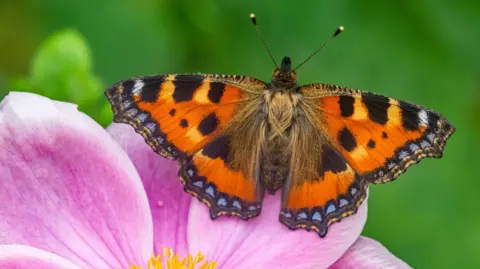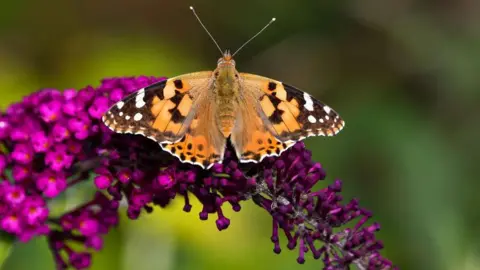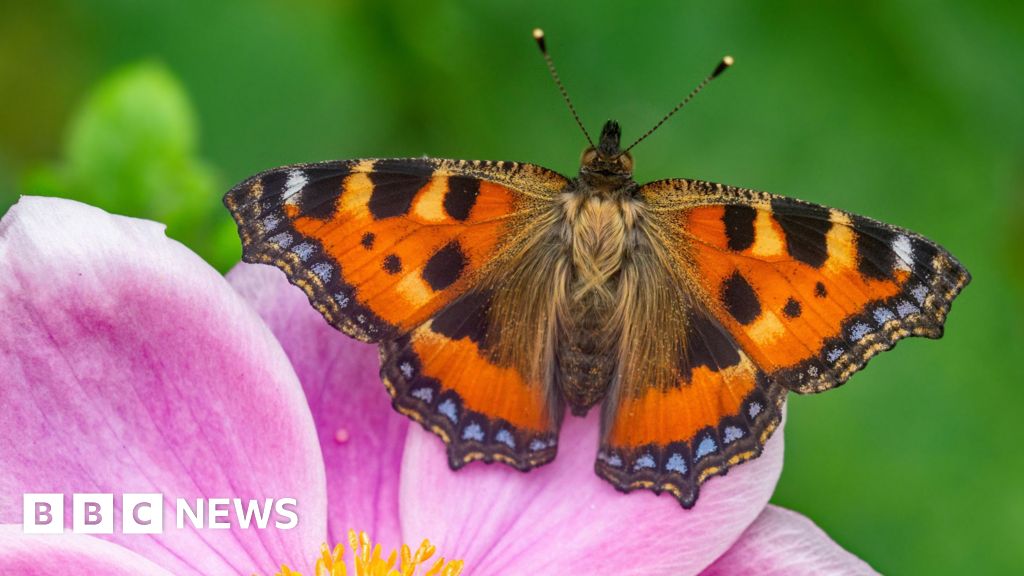 Andrew Cooper, Butterfly Conservation
Andrew Cooper, Butterfly ConservationA wildlife charity has declared a national “butterfly emergency” after its annual Big Butterfly Count recorded its lowest ever numbers.
The count has been running for 14 years. This year’s poor results are partly down to the wet weather but the long-term trend is hugely concerning, says Butterfly Conservation.
It is calling on the government to ban pesticides that can harm butterflies and bees “before it’s too late”.
Butterflies are at “their lowest ebb” on the back of 50 years of decline, said the charity’s head of science, Dr Richard Fox.
“Butterflies are a key indicator species; when they are in trouble we know that the wider environment is in trouble too,” he said.
Neonicotinoid pesticides were banned in the UK in 2018 but have been approved four times in a row in emergencies to tackle a virus that attacks sugar beet.
A spokesperson from the Department for Environment Food and Rural Affairs said it was “committed to deliver for nature and will change existing policies, including banning the use of those neonicotinoid pesticides that threaten vital pollinators” – but has given no time scales for doing so.


The Nature Friendly Farming Network, which represents farmers working to improve nature, called for support for farmers and consumers wanting to step away from such products.
“This disastrous decline in butterfly numbers is deeply concerning, but changing the way we manage our farm landscapes can play a critical role in halting biodiversity decline,” said CEO, Martin Lines.
He said it was essential to move away from the use of pesticides in farming and instead “embrace nature-friendly alternatives such as creating habitats for pollinators and predatory insects”.
But the National Farmers Union (NFU) said many factors, including weather extremes and record temperatures will have played their part in the decline of butterflies.
NFU environment forum chair, Richard Bramley, said: “The inclusion of neonicotinoids in this debate is unhelpful and misleading. There is no clear scientific evidence to show this pesticide use in the decline of butterfly numbers.”


The 2024 Big Butterfly Count took place in July and August across the UK when thousands of people recorded over a period of 15 minutes how many butterflies they saw, even if it was none.
Overall, participants spotted seven butterflies on average per count, the lowest in the scheme’s 14-year history. Last year’s average was 12.
Butterfly Conservation said it was the worst year recorded for the common blue, holly blue, green-veined white, small white, small tortoiseshell, painted lady and Scotch argus.
This year’s fall in butterfly numbers is thought to have been made worse by the wet spring coupled with the late arrival of summer heat.
Wider data from the UK Butterfly Monitoring Scheme – one of the longest running insect monitoring schemes in the world – shows yearly fluctuations in butterfly numbers in response to weather conditions amid a long-term picture of decline driven by climate change, habitat loss, pollution and pesticides.
Dr Marc Botham of the UK Centre for Ecology and Hydrology said 33% of species had shown a significant decline in their abundance on monitored sites in the UK over the past 48 years.
“It’s quite simple really – there’s not enough habitat and what is there isn’t good quality,” he said.
“We need to be putting [measures] in place to increase the amount and quality of habitat so that [butterflies and other wildlife] can do better.”


